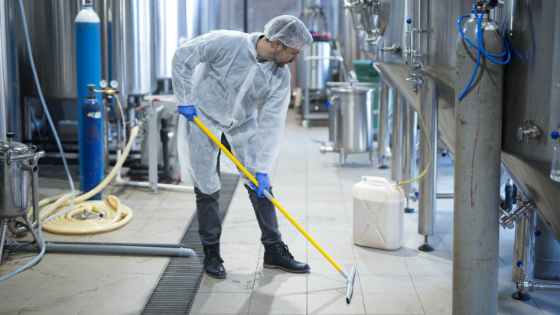The institutional and industrial cleaning industry helps prevent health risks for several working environments. But the industry itself comes with its own set of hazards, and since workers can move between several different work environments, it can be difficult for employers to control hazards.
That said, employers are responsible for their workers’ wellbeing, just like any other industry. Here are some of the most common hazards in the cleaning industry and the standards that employers should know.
Common Cleaning Hazards
Since institutional and industrial cleaning is such a varied industry, you cannot control for hazards in every individual workplace. After all, someone cleaning an office and someone cleaning a factory are two very different cleaners with very different risks. What you can do is control for hazards that are consistent for all cleaning workers. This includes things like hazardous materials, confined spaces, ventilation, and ergonomics.
Cleaning Chemicals
Some janitorial cleaning services use different cleaning chemicals and these are considered one of the most common risks posed to cleaning workers, as they interact with them on a daily basis.
However, the amount of risk posed by a product depends on a number of factors, including:
- Ingredients used in the product
- How the product is stored
- How the product is used
- Ventilation in the area where the product is used
- Whether the product comes in contact with the skin
- Whether any gases or vapors are released during use
As an employer, the best way to keep your workers safe is to determine the exact commercial cleaning needs of the job. If cleaning chemicals aren’t necessary, employees shouldn’t use them.
If they are necessary, take the time to review any health hazards associated with certain chemicals so that you can train your employees accordingly. You should also take the time to train employees in the proper usage and safe storage of these chemicals and how to safely clean up chemical spills.
You should also provide employees with the appropriate safety equipment, like protective gloves and other personal protective equipment (PPE).
Confined Spaces
Another common hazard for cleaning staff is confined spaces, especially when combined with potentially harmful chemicals. The biggest issue with confined spaces is airflow (or rather, the lack of it). As such, the atmosphere in a confined space may be wildly different than the atmosphere outside.
On one hand, the air may not have enough oxygen to breathe. On the other hand, it could contain so much oxygen that fire is much more likely if there’s an ignition point. And if the airflow is poor, your employees may be stuck breathing in harmful cleaning chemicals.
Keep in mind that certain confined spaces require permits before workers can enter them. You also have different ventilation requirements in confined spaces to ensure employee safety.
Ergonomics
Ergonomics is the notion of shaping a job to fit the worker, rather than forcing the worker to fit the job. This helps reduce the risk of workplace-related injuries.
Cleaning staff, in particular, have their own set of ergonomic risks, from heavy lifting to sweeping and scrubbing to moving furniture.
As an employer, you are responsible for ensuring that your employees know how to work safely and providing them with the means to do so. For example, teaching employees how to safely lift heavy objects, or providing long-handled mops so that employees don’t have to bend to scrub floors.
Bringing Together the Cleaning Industry and Safety Standards
The best way to prevent safety risks is to know your responsibilities. This is where the cleaning industry and safety standards come together. Of course, staying on top of your compliance requirements is a full-time job in its own right. That’s why you need the right ideas and solutions for the job. For more workplace safety strategies, visit the EHS Insight Blog.
